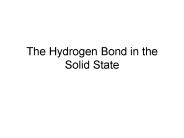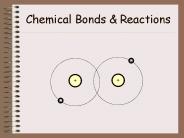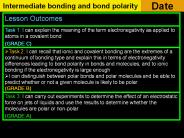Hydrogen Bond PowerPoint PPT Presentations
All Time
Recommended
Single Bonds= __ e- s Double Bonds= __ e- s Triple Bonds=__ e- s ... VSEPR Theory: Molecular Shapes Most shapes are based on a _____. Examples: CH4 ...
| PowerPoint PPT presentation | free to view
These attractive forces create weak bonds called hydrogen bonds. Compounds Important to Life ... liquid RT*; vegetable oils. Cholesterol -C-C=C-C-C=C-C-C ...
| PowerPoint PPT presentation | free to view
Hydrogen bonds What are they? A special case of permanent dipole-dipole interactions They are stronger than van der Waals forces. Molecules with hydrogen bonds have ...
| PowerPoint PPT presentation | free to download
Chemical Bonding Ionic, Covalent, Metallic and Hydrogen Bonds
| PowerPoint PPT presentation | free to download
This brief outline of the hydrogen bond between water ... to another atom Geometry The dissociation energy is around 3 5 kcalmol We know of ...
| PowerPoint PPT presentation | free to download
... in the outer most electron level of an atom, it involves the valance electrons ... Valance electrons are either shared or gained/lost in chemical bonds. Ions ...
| PowerPoint PPT presentation | free to view
Compare and contrast ionic, covalent, and hydrogen bonds. ... For Bio-Student Only Title: What role does pH play in living systems and the environment. Author:
| PowerPoint PPT presentation | free to download
Harnessing Hydrogen for Power: Hydrogen Cars Marisa Katz Hannah Lobingier What exactly is a Hydrogen Car In a hydrogen car, its primary source of power is from ...
| PowerPoint PPT presentation | free to download
1. When a hydrogen atom bonded to a very electronegative atom is also attracted to another electronegative atom hydroxyl 18. Carbon + Oxygen with a dbl bond carbonyl ...
| PowerPoint PPT presentation | free to view
Design and Synthesis of Calixarene Scaffolds Bearing Hydrogen Bond Motifs Farzad Fani-Pakdel and Jason R. Telford Department of Chemistry, University of Iowa
| PowerPoint PPT presentation | free to download
Hydrogen Bonds (for AP120 & BIO120)* * From a chemistry standpoint, some of this is incorrect or a gross over-simplification, but it gives you the right idea and ...
| PowerPoint PPT presentation | free to view
Hydrogen bonds in Rosetta. Structure-derived potential of KMB03. Existing definition/scoring ... Rosetta does well at optimizing what it is told. ...
| PowerPoint PPT presentation | free to view
How much is a hydrogen bond worth? ... Hydrogen Bonding. The Hydrophobic Effect ... Each molecule of water in the solid state is engaged in 4.0 hydrogen bonds. ...
| PowerPoint PPT presentation | free to view
Look at electronegativity values. H = 2.1 N = 3.0 O = 3.5. O-H & N-H ... What is a hydrogen bond then? How does it form? A simple model is shown here: H. O ...
| PowerPoint PPT presentation | free to view
Figure 3.2 Hydrogen bonds between water molecules. Evolution. Living cells are 70-95% H2O ... (540 cal/g or 2260 J/g; Joule = 0.239 cal) ...
| PowerPoint PPT presentation | free to view
Bonds are relatively weak and easily broken in chemical reactions. ... Types of intermolecular forces (noncovalent interactions) (nonbonded interactions) ...
| PowerPoint PPT presentation | free to view
types of chemical bonds ionic bonds covalent bonds hydrogen bonds metallic bonds
| PowerPoint PPT presentation | free to download
All are stable except for tritium. synthesized in the ... enclosed behind bars. gas hydrates. methane. noble gases. Biological Aspects of Hydrogen Bonding ...
| PowerPoint PPT presentation | free to download
BONDS Valence electrons do the bonding- look at your chart GOALS To fill up the energy level They can do that by giving away electrons Or by receiving electrons
| PowerPoint PPT presentation | free to view
Covalent Bonds Other Bonds James Treasury Sen. Kit Bond Bond Bond
| PowerPoint PPT presentation | free to view
Chemical Bonds Three basic types of bonds: Ionic Electrostatic attraction between ions Covalent Sharing of electrons Metallic Metal atoms bonded to several other atoms
| PowerPoint PPT presentation | free to download
The chemical bond when two atoms SHARE electrons. Usually form between atoms of NONMETALS or between a NONMETAL HYDROGEN. ... By sharing electrons, each atom ...
| PowerPoint PPT presentation | free to view
hydrogen unit 9 prepared by prashanth c p kv ganeshkhind pune.
| PowerPoint PPT presentation | free to view
Ionic Bonds Lewis Structures Nonpolar and Polar Covalent Bonds Electronegativity Bond Length, Energy and Order Formal Charges Resonance Structures Exceptions to the ...
| PowerPoint PPT presentation | free to view
Covalent Bonds! Covalent bond Between two nonmetals; sharing of the valence electrons Covalent bonds are weaker than Ionic bonds A molecule is the smallest part of a ...
| PowerPoint PPT presentation | free to download
As you go down a group, the boiling points of hydrides increase But look now at periods 5, 6 and 7: The first element is unusually high due to hydrogen bonding!
| PowerPoint PPT presentation | free to download
Chemistry B11 Chapter 3 Chemical Bonds Polarity Molecule has polar bonds. Its centers of + and - lie at different places (sides). O = C = O - + - nonpolar ...
| PowerPoint PPT presentation | free to view
Chemical Bonds & Reactions-+ +-Chemical Bond A force of attraction that holds two atoms together Has a significant effect on chemical and physical properties of ...
| PowerPoint PPT presentation | free to download
... Hydrogen Molecule Methane Molecule Slide 5 Hybridization of Carbon s Orbitals Slide 7 Valence Bond Model of Methane Ammonia and Water Hybridization for a ...
| PowerPoint PPT presentation | free to view
Bond Attraction. Intramolecular Bonding. Metallic, Covalent, ... Intermolecular Bonding. Due to Molecule Polarity. Hydrogen Bonding, Molecule-Ion. Hydrogen Bonds ...
| PowerPoint PPT presentation | free to view
Covalent bond Water molecule Sterilising Even after it has been packaged, gamma rays can be used to kill bacteria, mould and insects in food. This process prolongs ...
| PowerPoint PPT presentation | free to download
chemical bonding ionic bonds covalent bonds hydrogen bonds metallic bonds
| PowerPoint PPT presentation | free to download
CHEMICAL BONDS ... atoms are held together by forces known as chemical bonds. ... in order not to create confusion, chemical formulas of the reactants and the ...
| PowerPoint PPT presentation | free to view
Compounds and Bonds Chapter 2 - Chemical Interaction
| PowerPoint PPT presentation | free to view
Covalent Bonds Notes Single Bonds A bond in which two or more atoms share a pair of electrons H + H H-H Each hydrogen now achieves the electron configuration of ...
| PowerPoint PPT presentation | free to view
2.6 Hydrogen Bonding 2.6.1. Hydrogen Bonds LO: I understand what is meant by hydrogen bonding. The bonding in hydrogen fluoride is much stronger than can ...
| PowerPoint PPT presentation | free to download
Valence Bond Theory Double & Triple Bonds Now consider ethyne, or C2H2. The Lewis diagram predicts a triple bond between the carbons. Can you hypothesize what a ...
| PowerPoint PPT presentation | free to view
The Chemical Bond I Bonds as Orbital Overlap Molecular Orbital Diagrams Hybridization Additional Bonding Schemes
| PowerPoint PPT presentation | free to view
Show all of the steps needed to bond Sodium and Bromine. ... Fuel power grills. propane. CH4. Earths Crust deep in the ocean. Heating cooking Car fuel ...
| PowerPoint PPT presentation | free to download
Tradeasia International is a leading Hydrogen peroxide suppliers and exporters based in Singapore. Our quality hydrogen peroxide is best suited for preparing disinfectants, food processing, and more.
| PowerPoint PPT presentation | free to download
Chemical Bonds Standard 2: chapter 7, 8, 9 Vocabulary leave enough space for definition AND an example Metallic bond Alloy Ionic bond Cation Anion
| PowerPoint PPT presentation | free to download
Bonds as a Continuum Electronegativity Polar Bonding When identical atoms are covalently bonded together, the electrons are shared equally between them.
| PowerPoint PPT presentation | free to view
Intermediate bonding and bond polarity Date Lesson Outcomes Task 1: I can explain the meaning of the term electronegativity as applied to atoms in a covalent bond
| PowerPoint PPT presentation | free to download
Chapter 12 12.1 Types of Chemical Bonds 12.2 Electronegativity
| PowerPoint PPT presentation | free to download
If it has a subscript of more than one, use a prefix to tell how many of that atom there are. ... Carbon likes to make 4 bonds. Hydrogens around the outside ...
| PowerPoint PPT presentation | free to view
polar bonds and molecules notes 16.3
| PowerPoint PPT presentation | free to download
A chemical bond is a force holding two or more atoms together to form a molecule. Why do atoms form chemical bonds? Atoms tend to form chemical bonds to satisfy the ...
| PowerPoint PPT presentation | free to view
Hydrogen Bonding. Interaction btwn e--rich atom connected to ... Forms a convex meniscus. Doesn't 'climb' a glass tube. Due to cohesive forces adhesive forces ...
| PowerPoint PPT presentation | free to view
Polar Bonds and Molecules Bond Polarity The bonding pairs of electrons in covalent bonds are pulled between the nuclei of the atoms sharing the electrons.
| PowerPoint PPT presentation | free to download
Trends in the Periodic Table and Bonding Polar Covalent Bonds Covalent Bonding A covalent bond is a shared pair of electrons electrostatically attracted to the ...
| PowerPoint PPT presentation | free to view
Chemical Bonding I: The Covalent Bond Lewis dot symbols The covalent bond Electronegativity Writing Lewis structures Formal charge and Lewis structure
| PowerPoint PPT presentation | free to download
Model #1: Mass flow chemical reaction network. Model #2: ... Thermo-bonds ... Our thermo-bonds carry the mass flows measured in kg/s rather than in moles/sec. ...
| PowerPoint PPT presentation | free to download
Polar Bonds and Molecules Notes Bond Polarity The bonding pairs of electrons are pulled in a tug-of-war between the nuclei of the atoms sharing the electrons.
| PowerPoint PPT presentation | free to view
Chemical compounds are formed by the joining of two or more atoms. ... The bond means there is an attractive force between the atoms. ...
| PowerPoint PPT presentation | free to view
Chapter 6 Ionic and Covalent Bonds 1. What happens when the highest energy level is occupied Answer: Atom is stable and not likely to react with
| PowerPoint PPT presentation | free to download
How do we measure the degree of ionic or covalent character of a bond? ... Polar (NH3) (H2O) Network covalent (diamond Cx) (quartz SiO2(x)) Metallic (Fe, Cu) ...
| PowerPoint PPT presentation | free to view
























































